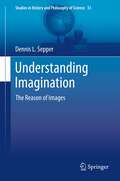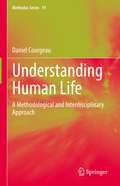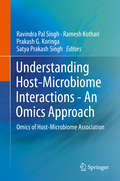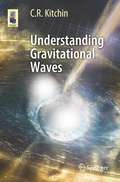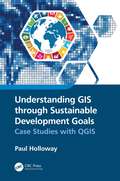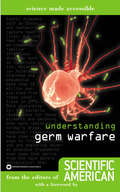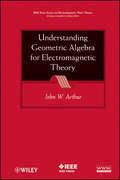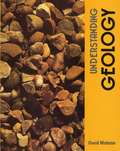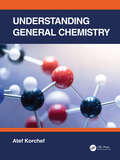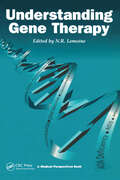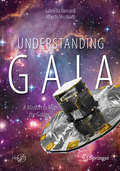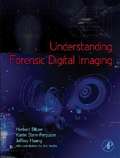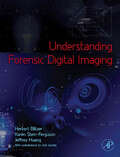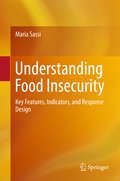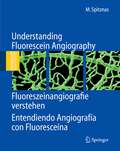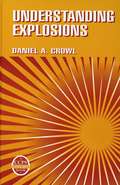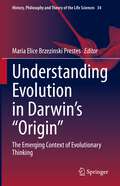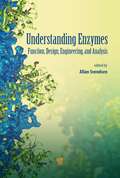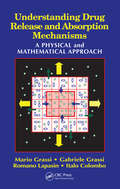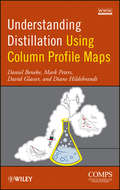- Table View
- List View
Understanding Imagination: The Reason of Images (Studies in History and Philosophy of Science #33)
by Dennis L SepperThis book discusses that imagination is as important to thinking and reasoning as it is to making and acting. By reexamining our philosophical and psychological heritage, it traces a framework, a conceptual topology, that underlies the most disparate theories: a framework that presents imagination as founded in the placement of appearances. It shows how this framework was progressively developed by thinkers like Plato, Aristotle, Descartes, and Kant, and how it is reflected in more recent developments in theorists as different as Peirce, Saussure, Wittgenstein, Benjamin, and Bachelard. The conceptual topology of imagination incorporates logic, mathematics, and science as well as production, play, and art. Recognizing this topology can move us past the confusions to a unifying view of imagination for the future.
Understanding Human Life: A Methodological and Interdisciplinary Approach (Methodos Series #19)
by Daniel CourgeauThis book addresses the challenge of understanding human life. It compares our life experience with the attempts to grasp it by astrologers, eugenicists, psychologists, neuroscientists, social scientists, and philosophers. The main opposition among these specialties lies between understanding and misunderstanding. The book also addresses the central methodological difficulty of capturing a human life. It is first examined how certain approaches may lead to a misunderstanding of human life. The book contrasts the example of astrology—an accepted practice in ancient civilizations, but now classified among the pseudosciences—with astronomy, a full-fledged science since Galileo’s time. Another, more recent approach regards human life as predetermined by genes: the methods used by eugenicists, and later by political regimes under the name of hereditarianism, came to compete with genetics. A broader analysis shows how astrology and eugenicism are not truly scientific approaches. Next, the book looks at the ways of capturing an imaginary or real human life story. A comprehensive approach will try to fully understand their complexity, while a more explanatory approach considers only certain specific phenomena of human life. For example, demography studies only births, deaths, and migration. Another crucial factor in the collection of life histories is memory and its transmission. Psychology and psychoanalysis have developed different schools to try to explain them. The book concludes with a detailed discussion of the concepts and tools that have been proposed in more recent times for understanding the various aspects of life stories: mechanisms, systems, hermeneutics, and autonomy.
Understanding Host-Microbiome Interactions - An Omics Approach: Omics of Host-Microbiome Association
by Ravindra Pal Singh Ramesh Kothari Prakash G. Koringa Satya Prakash SinghThis book offers up-to-date information on different microbiomes, their community composition and interactive functions with the host, bringing together information from diverse research reports to provide an overview of the rapid developments in meta-omics technologies. It is a valuable resource for scientists, researchers, postgraduate and graduate students interested in understanding the impact and importance of next generation sequencing technologies on different hosts and their microbiomes.
Understanding Gravitational Waves (Astronomers' Universe)
by C. R. KitchinThe birth of a completely new branch of observational astronomy is a rare and exciting occurrence. For a long time, our theories about gravitational waves—proposed by Albert Einstein and others more than a hundred years ago—could never be fully proven, since we lacked the proper technology to do it. That all changed when, on September 14, 2015, instruments at the LIGO Observatory detected gravitational waves for the first time. This book explores the nature of gravitational waves—what they are, where they come from, why they are so significant and why nobody could prove they existed before now. Written in plain language and interspersed with additional explanatory tutorials, it will appeal to lay readers, science enthusiasts, physical science students, amateur astronomers and to professional scientists and astronomers.
Understanding GIS through Sustainable Development Goals: Case Studies with QGIS
by Paul HollowayUnderstanding GIS through Sustainable Development Goals applies a pedagogical shift to learning GIS, as the readers employ the concepts and methodologies on real-world problems. This book provides 16 case studies across most of the Sustainable Development Goals (SDGs) with step-by-step practical instructions using QGIS(Quantum Geographic Information System) , an open-source software. It helps readers develop GIS skills on real-world data, while learning the fundamentals such as spatial data models, projections, and spatial databases, different cartographic methods, such as graduated symbology, change maps, and dynamic visualization, as well as more intermediate and advanced spatial analysis such as geoprocessing, multiple criteria analysis, and spatial statistics. The topics chosen are taught in secondary and tertiary education institutions which make this a textbook for all students and educators. Features: Focuses on learning GIS through 16 real world case studies. Introduces an open-source software that can be used beyond the classroom. Analyzes Sustainable Development Goals in a global framework and provides an alternative approach to learning GIS. Supports both secondary and tertiary educators and improves GIS education at all levels. Contains a holistic range of case studies that extend across several disciplines, from geography education, environmental sciences, geosciences, natural sciences, social sciences, and digital humanities. This is a textbook for all students and educators, providing 16 case studies across most of the SDGs with step-by-step practical instructions using QGIS, an open-source software.
Understanding GIS through Sustainable Development Goals: Case Studies with QGIS
by Paul HollowayUnderstanding GIS through Sustainable Development Goals applies a pedagogical shift to learning GIS, as the readers employ the concepts and methodologies on real-world problems. This book provides 16 case studies across most of the Sustainable Development Goals (SDGs) with step-by-step practical instructions using QGIS(Quantum Geographic Information System) , an open-source software. It helps readers develop GIS skills on real-world data, while learning the fundamentals such as spatial data models, projections, and spatial databases, different cartographic methods, such as graduated symbology, change maps, and dynamic visualization, as well as more intermediate and advanced spatial analysis such as geoprocessing, multiple criteria analysis, and spatial statistics. The topics chosen are taught in secondary and tertiary education institutions which make this a textbook for all students and educators. Features: Focuses on learning GIS through 16 real world case studies. Introduces an open-source software that can be used beyond the classroom. Analyzes Sustainable Development Goals in a global framework and provides an alternative approach to learning GIS. Supports both secondary and tertiary educators and improves GIS education at all levels. Contains a holistic range of case studies that extend across several disciplines, from geography education, environmental sciences, geosciences, natural sciences, social sciences, and digital humanities. This is a textbook for all students and educators, providing 16 case studies across most of the SDGs with step-by-step practical instructions using QGIS, an open-source software.
Understanding Germ Warfare
by Editors of Scientific AmericanWritten for the popular reader, this small volume contains short chapters on the science behind germ warfare. How diseases occur, the creation and use of vaccines, viral genomics, and resistance to antibiotics are some of the topics. Annotation copyrighted by Book News, Inc., Portland, OR
Understanding Geometric Algebra for Electromagnetic Theory (IEEE Press Series on Electromagnetic Wave Theory #38)
by John W. ArthurThis book aims to disseminate geometric algebra as a straightforward mathematical tool set for working with and understanding classical electromagnetic theory. It's target readership is anyone who has some knowledge of electromagnetic theory, predominantly ordinary scientists and engineers who use it in the course of their work, or postgraduate students and senior undergraduates who are seeking to broaden their knowledge and increase their understanding of the subject. It is assumed that the reader is not a mathematical specialist and is neither familiar with geometric algebra or its application to electromagnetic theory. The modern approach, geometric algebra, is the mathematical tool set we should all have started out with and once the reader has a grasp of the subject, he or she cannot fail to realize that traditional vector analysis is really awkward and even misleading by comparison. Professors can request a solutions manual by email: pressbooks@ieee.org
Understanding Geometric Algebra for Electromagnetic Theory (IEEE Press Series on Electromagnetic Wave Theory #38)
by John W. ArthurThis book aims to disseminate geometric algebra as a straightforward mathematical tool set for working with and understanding classical electromagnetic theory. It's target readership is anyone who has some knowledge of electromagnetic theory, predominantly ordinary scientists and engineers who use it in the course of their work, or postgraduate students and senior undergraduates who are seeking to broaden their knowledge and increase their understanding of the subject. It is assumed that the reader is not a mathematical specialist and is neither familiar with geometric algebra or its application to electromagnetic theory. The modern approach, geometric algebra, is the mathematical tool set we should all have started out with and once the reader has a grasp of the subject, he or she cannot fail to realize that traditional vector analysis is really awkward and even misleading by comparison. Professors can request a solutions manual by email: pressbooks@ieee.org
Understanding Geology (PDF)
by David WebsterThe carefully sequenced content ensures a logical build-up of key ideas, and cross-referencing between chapters enables pupils to integrate all aspects of the subject. Each chapter is broken into manageable short sections for ease of use, and ends with a set of data-response questions. The Fieldwork Appendix provides practical guidelines for preparing and conducting field-work, and there are ideas for practical work which link to each chapter.
Understanding General Chemistry
by Atef KorchefUnderstanding General Chemistry details the fundamentals of general chemistry through a wide range of topics, relating the structure of atoms and molecules to the properties of matter. Written in an easy-to-understand format with helpful pedagogy to fuel learning, the book features main objectives at the beginning of each chapter, get smart sections, and check your reading section at the end of each chapter. The text is filled with examples and practices that illustrate the concepts at hand. In addition, a summary, and extensive MCQs, exercises and problems with the corresponding answers and explanations are readily available. Additional features include: Alerts students to common mistakes and explains in simple ways and clear applications how to avoid these mistakes. Offers answers and comments alongside sample problems enabling students to self-evaluate their skill level. Includes powerful methods, easy steps, simple and accurate interpretations, and engaging applications to help students understand complex principles. Provides a bridge to more complex topics such as solid-state chemistry, organometallic chemistry, chemistry of main group elements, inorganic chemistry, and physical chemistry. This introductory textbook is ideal for chemistry courses for non-science majors as well as health sciences and preparatory engineering students.
Understanding General Chemistry
by Atef KorchefUnderstanding General Chemistry details the fundamentals of general chemistry through a wide range of topics, relating the structure of atoms and molecules to the properties of matter. Written in an easy-to-understand format with helpful pedagogy to fuel learning, the book features main objectives at the beginning of each chapter, get smart sections, and check your reading section at the end of each chapter. The text is filled with examples and practices that illustrate the concepts at hand. In addition, a summary, and extensive MCQs, exercises and problems with the corresponding answers and explanations are readily available. Additional features include: Alerts students to common mistakes and explains in simple ways and clear applications how to avoid these mistakes. Offers answers and comments alongside sample problems enabling students to self-evaluate their skill level. Includes powerful methods, easy steps, simple and accurate interpretations, and engaging applications to help students understand complex principles. Provides a bridge to more complex topics such as solid-state chemistry, organometallic chemistry, chemistry of main group elements, inorganic chemistry, and physical chemistry. This introductory textbook is ideal for chemistry courses for non-science majors as well as health sciences and preparatory engineering students.
Understanding Gene Therapy
by Prof Nick LemoineThis title explains what gene therapy is, how genes are delivered and how they are targeted. It discusses recent gene therapy trials, future applications and considers the ethical and safety issues surrounding gene therapy. Understanding Gene Therapy is a
Understanding Gene Therapy
by Prof Nick LemoineThis title explains what gene therapy is, how genes are delivered and how they are targeted. It discusses recent gene therapy trials, future applications and considers the ethical and safety issues surrounding gene therapy. Understanding Gene Therapy is a
Understanding Gaia: A Mission to Map the Galaxy (Springer Praxis Books)
by Gabriella Bernardi Alberto VecchiatoThis book is the first to provide a comprehensive, readily understandable report on the European Space Agency’s Gaia mission that will meet the needs of a general audience. It takes the reader on an exciting journey of discovery, explaining how such a scientific satellite is made, presenting the scientific results available from Gaia to date, and examining how the collected data will be used and their likely scientific consequences. The Gaia mission will provide a complete and high-precision map of the positions, distances, and motions of the stars in our galaxy. It will revolutionize our knowledge on the origin and evolution of the Milky Way, on the effects of mysterious dark matter, and on the birth and evolution of stars and extrasolar planets. The Gaia satellite was launched in December 2013 and has a foreseen operational lifetime of five to six years, culminating in a final stellar catalogue in the early 2020s. This book will appeal to all who have an interest in the mission and the profound impact that it will have on astronomy.
Understanding Forensic Digital Imaging (PDF)
by Herbert L. Blitzer Karen Stein-Ferguson Jeffrey HuangUnderstanding Forensic Digital Imaging offers the principles of forensic digital imaging and photography in a manner that is straightforward and easy to digest for the professional and student. It provides information on how to photograph any setting that may have forensic value, details how to follow practices that are acceptable in court, and recommends what variety of hardware and software are most valuable to a practitioner. In addition to chapters on basic topics such as light and lenses, resolution, and file formats, the book contains forensic-science-specific information on SWGIT and the use of photography in investigations and in court. Of particular note is Chapter 17, Establishing Quality Requirements, which offers information on how to create a good digital image, and is more comprehensive than any other source currently available. Covers topics that are of vital importance to the practicing professional Serves as an up-to-date reference in the rapidly evolving world of digital imaging Uses clear and concise language so that any reader can understand the technology and science behind digital imaging
Understanding Forensic Digital Imaging
by Herbert L. Blitzer Karen Stein-Ferguson Jeffrey HuangUnderstanding Forensic Digital Imaging offers the principles of forensic digital imaging and photography in a manner that is straightforward and easy to digest for the professional and student. It provides information on how to photograph any setting that may have forensic value, details how to follow practices that are acceptable in court, and recommends what variety of hardware and software are most valuable to a practitioner. In addition to chapters on basic topics such as light and lenses, resolution, and file formats, the book contains forensic-science-specific information on SWGIT and the use of photography in investigations and in court. Of particular note is Chapter 17, Establishing Quality Requirements, which offers information on how to create a good digital image, and is more comprehensive than any other source currently available.Covers topics that are of vital importance to the practicing professionalServes as an up-to-date reference in the rapidly evolving world of digital imagingUses clear and concise language so that any reader can understand the technology and science behind digital imaging
Understanding Food Insecurity: Key Features, Indicators, and Response Design
by Maria SassiThis book provides a comprehensive overview of key aspects of food insecurity, including definitional and conceptual issues, information systems and data sources, indicators, and policies. The aim is to equip readers with a sound understanding of the subject that will assist in the recognition of food insecurity and the design of suitable responses. The early chapters discuss the evolution and limitations of the concept and provide a set of conceptual frameworks for the analysis of food security. Systems used to collect data and their evolution over time are then explained, and the most commonly adopted indicators for monitoring food security are presented. Approaches to food security are then thoroughly reviewed decade by decade. Specific attention is paid to the food insecurity challenge in the new millennium, focusing particularly on recent food crises and institutional and policy-related consequences. Finally, the specific terminology of food aid and assistance is examined, with discussion of the instruments recently adopted in the food aid system. This book will be an informative and stimulating resource for both students and professionals.
Understanding Fluorescein Angiography, Fluoreszeinangiografie verstehen, Entendiendo Angiografía con Fluoresceína
by Manfred SpitznasFluorescein angiography is an indispensable tool in ophthalmology. It is founded on the evaluation of phenomena related to the behavior intravenously administered sodium fluorescein in the tissues of the ocular fundus. This book deals with the morphological prerequisites and structural changes on which the individual phenomena are based. It provides the retina specialist, the general ophthalmologist, and the basic scientist with valuable information toward understanding the nature and mechanism of the underlying disorders.
Understanding Explosions (A CCPS Concept Book #16)
by Daniel A. CrowlThere are many different types of explosions, each with its own complex mechanism. Understanding explosions is important in preventing them. This reference provides valuable information on explosions for everyone involved in the operation, design, maintenance, and management of chemical processes, helping enhance understanding of the nature of explosions and the practical methods required to prevent them from occurring. The text includes: Fundamental basis for explosions Explosive and flammable behavior and characteristics of materials Different types of explosions Fire and explosion hazard recognition Practical methods for preventing explosions or minimizing the potential consequences Additional references Understanding Explosions provides a practical understanding of explosion fundamentals, including the different types of explosions, the explosive and flammable behavior of materials, and the hazards related to fires and explosions. It also discusses practical methods to prevent and minimize the probability and consequence of an explosion during routine use of flammable, combustible and/or reactive materials.
Understanding Evolution in Darwin's "Origin": The Emerging Context of Evolutionary Thinking (History, Philosophy and Theory of the Life Sciences #34)
by Maria Elice Brzezinski PrestesThis book aims to encourage the reading of "On the Origin of Species" and to include it in the teaching of evolution. With a comprehensive overview of the development of Darwin's theory, the volume provides relevant aspects of Darwin's life and work in connection with the broader context of his time. The historical and philosophical analysis, mirrored in the socio-cultural scope, enables the diachronic reading of the text. It is built on various sources of historians and philosophers of science and sheds fresh light on them. Its uniqueness is the broad structure that covers four parts: the pre-Darwinian concepts of species changes; some key elements of Darwin's pursuit of the causes of evolution, from his voyage on Beagle to the publication of his groundbreaking work; chapter-by-chapter analysis of the "Origin"; and subsequent developments in evolutionary thought. This book is of interest to undergraduate and graduate students, scholars in history, philosophy, and sociology of science and science education, as well as the general public.
Understanding Enzymes: Function, Design, Engineering, and Analysis
by Allan SvendsenUnderstanding Enzymes: Function, Design, Engineering, and Analysis focuses on the understanding of enzyme function and optimization gained in the past decade, past enzyme function analysis, enzyme engineering, and growing insights from the simulation work and nanotechnology measurement of enzymes in action in vitro or in silico. The book also prese
Understanding Environmental Issues (PDF)
by Susan Buckingham Mike Turner"Understanding Environmental Issues provides an excellent foundation for developing critical thinking about contemporary environmental concerns and the ways in which these are debated, represented and managed. The book should achieve its aim of stimulating students to engage with how ideas of sustainability and environmental justice can be applied both in policy and in practical action." - Gordon Walker, Lancaster Environment Centre, Lancaster University "The arena of environmental issues is a minefield for undergraduate students seeking clarity about key problems and solutions. This is where Understanding Environmental Issues will play a major role, providing a stimulating guide through the wealth of material and complex ideas. In particular the unification of social and physical science in the case studies provides a holistic approach to the subject that is essential for students and a refreshing innovation for environmental textbooks." - Anna R. Davies, Trinity College, University of Dublin There is now an unprecedented interest in, and concern about, environmental problems. Understanding Environmental Issues explains the science behind these problems, as well as the economic, political, social, and cultural factors which produce and reproduce them. This book: Explains, clearly and concisely, the science and social science necessary to understand environmental issues. Describes - in section one - the philosophies, values, politics, and technologies which contribute to the production of environmental issues. Uses cases on climate change, waste, food, and natural hazards in section two to provide detailed illustration and exemplification of the ideas described in section one. The conclusion, a case study of Mexico City, draws together the key themes Vivid, accessible and pedagogically informed, Understanding Environmental Issues will be a key resource for undergraduate and taught postgraduate students in Geography, Environment, and Ecology; as well as students of the social sciences with an interest in environmental issues.
Understanding Drug Release and Absorption Mechanisms: A Physical and Mathematical Approach
by Mario Grassi Gabriele Grassi Romano Lapasin Italo ColomboDemand for better reliability from drug delivery systems has caused designers and researchers to move away from trial-and-error approaches and toward model-based methods of product development. Developing such models requires cross-disciplinary physical, mathematical, and physiological knowledge. Combining these areas under a single cover, Under
Understanding Distillation Using Column Profile Maps
by Daniel Beneke Mark Peters David Glasser Diane HildebrandtResearchers share their pioneering graphical method for designing almost any distillation structure Developed by the authors in collaboration with other researchers at the Centre of Material and Process Synthesis, column profile maps (CPMs) enable chemical engineers to design almost any distillation structure using novel graphical techniques. The CPM method offers tremendous advantages over other design methods because it is generalized and not constrained to a particular piece of equipment. Understanding Distillation Using Column Profile Maps enables readers to understand, analyze, and design distillation structures to solve common distillation problems, including distillation by simple columns, side rectifiers and strippers, multiple feed columns, and fully thermally coupled columns. In addition, the book presents advanced topics such as reactive distillation, membrane permeation, and validation of thermodynamic models. For all these processes, the authors set forth easy-to-follow design techniques, solution strategies, and insights gained using CPMs. This book offers everything needed to fully understand and use CPMs as a design tool: Figures help readers understand how to use CPMs as design and optimization tools Examples clearly illustrate how to solve specific problems using CPMs Tutorials allow readers to explore key concepts through experimentation Design and Optimization of Distillation Systems software package, developed for this book, enables readers to reproduce the examples in the book, follow the tutorials, and begin designing their own distillation systems With its many examples and step-by-step tutorials, Understanding Distillation Using Column Profile Maps is recommended for students in chemical engineering in advanced undergraduate and graduate courses. The book also provides new practical techniques that can be immediately applied by chemical engineering professionals in industry.
